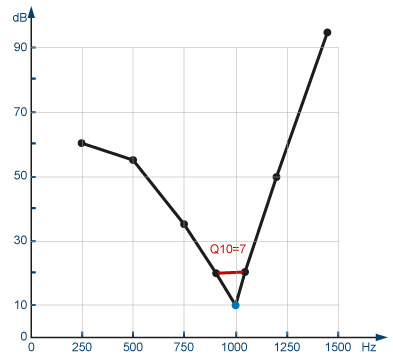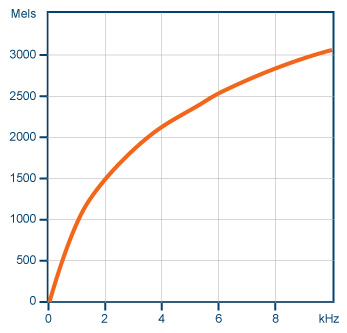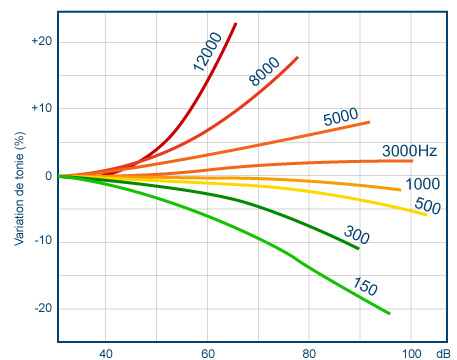Pitch
The sensation of pitch allows us to qualify a sound as low or high. This perceptual characteristic is essentially linked to frequency. Timbre is a more complex notion, allowing the distinction between two sound sources outputting the same sound signal. Timbre is essentially derived from the spectral composition of a sound.
Frequency discrimination
Frequency discrimination refers to the ear’s ability to perceive the difference between two pure tones of different frequencies, but the same sound level, presented sequentially..
Buser (1987) or Zwicker showed that for sound intensities between 40 and 70 dB, the smallest variation of pitch that a healthy ear can detect relative to a reference frequency is 0.0035. This relative threshold is true for frequencies between 200 and 5000Hz. At more extreme frequencies, pitch sensitivity is greatly decreased.
Using the relative threshold, it is easy to determine the smallest pitch variation that the human ear can perceive by multiplying it by the reference frequency. For example, at 1000 Hz, the smallest variation is 0.0035 x 1000 = 3.5 Hz. At 5000 Hz, it is 0.0035 x 500 = 17.5 Hz.
Frequency selectivity
Frequency selectivity refers to the ability to distinguish between two sounds that are produced simultaneously. It can be demonstrated using electrophysiology, but also using psychoacoustics.

This graph shows the minimal intensity required for a sound of a particular frequency (shown on the x axis) to mask the test frequency. For example, a masking sound of 750 Hz would need to be presented at 35 dB in order to mask a 1000 Hz sound presented at 10 dB.
The steeper the slope of the curve, the more selective the ear is at that frequency. To define a normal limit, the Q10 is calculated, which corresponds to the ratio between the test frequency and the frequency gap between the two frequencies which mask the test frequency when presented at 10 dB over its intensity.
In this example, the frequencies that mask the test sound when presented at 10 dB over its intensity are 900 and 1050 Hz. The Q10 is therefore 1000/(1050-900) ≈ 7.
The Q10 is considered to be normal when it is greater than 4.3.
Finally, it is apparent that this curve is wide, but has a greater slope in the higher frequency range than in the lower frequencies. This shows that lower frequencies are better maskers than higher frequencies.
The mel scale
Just like for loudness, there exists a scale to indicate the relative perception of two sounds of different pitch: this is the mel scale, which has the mel as its unit.

Under 500 Hz, pitch increases linearly with frequency: the Hz scale is equal to the mel scale.
Over 500 Hz, pitch varies logarithmically with frequency: the latter increases at a greater rate than the sensation of pitch. It is estimated that there are 620 pitch levels, each one representing around 4 mels, or, if they are spread over the basilar membrane, 52 micrometres (roughly 6 hair cells).
Factors that influence pitch
Intensity level

The pitch of mid frequencies does not change with intensity level. However, lower pitches tend to be lower and higher pitches are higher when the intensity level increases.
Sound duration
When a sound is short, it loses its spectral purity. Therefore, the shorter a sound, the lower its pitch.
Diplacusis (interaural pitch difference)
Binaural diplacusis describes when a pure tone has a different pitch when it is heard with the left or right ear. Although more pronounced in hearing-impaired listeners, it also occurs to a certain degree in normal-hearing individuals. The pitch difference has been estimated to be around 3%.
Masking
When certain components of a sound are masked by another sound, pitch can be altered.
Timbre
Timbre is the component of hearing that allows us to distinguish between two sounds of same loudness and pitch. The timbre of a sound is essentially linked to its spectral composition, but also its evolution over time (such as the shape of the spectral envelope or the ‘attack’ of the sound…).
In this way, it is possible to determine the origin of a particular group of sounds. The most common example is the ability to distinguish between different musical instruments. Only timbre allows the distinction between two instruments that are playing the same note (see the chapter ‘Music’).